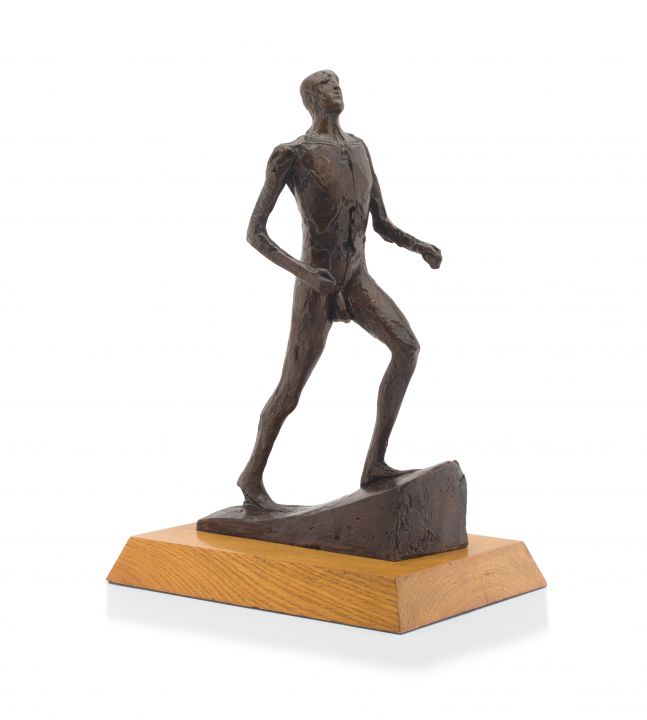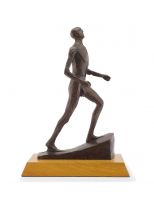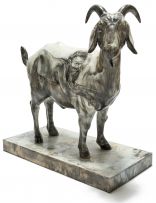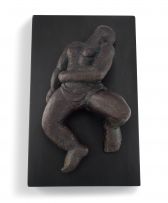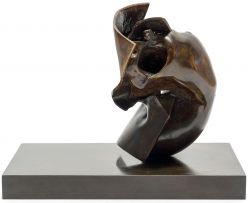Modern, Post-War and Contemporary Art, Decorative Arts, Jewellery and Fine Wine
Live Virtual Auction, 8 - 11 November 2020
Modern, Post-War and Contemporary Art Part II
About this Item
signed and numbered 7/8
Notes
While the defining characteristic of the Amadlozi Group had been a dedication to a bold if admittedly diverse African aesthetic, from the mid-1960s a greater international influence on the work of these artists became evident. Villa, of course, already steeped in European modernism, was little affected, as was Skotnes who, in his role as teacher at Polly Street, had always kept an eye on international trends; Kumalo and Legae, however, were perhaps more receptive to new sources, particularly as their careers advanced and they became more sensitive to collectors' tastes.
A shift came in 1965 as the Grosvenor Gallery, the prestigious Mayfair landmark run by the American Eric Estorick, showed increasing interest in Egon Guenther's stable of contemporary sculptors. He would have known the work of Villa, Skotnes and Kumalo in particular, as each had, in the decade prior, regularly shown at the Venice and São Paulo Biennales. Estorick, accompanied by his then assistant Linda Goodman, famously visited Guenther in 1964 and 1965 to negotiate the possibility of cross-gallery partnerships. This led that year to Kumalo participating in the Grosvenor Gallery's Fifty Years of Sculpture exhibition, as well as a Skotnes-Kumalo show in London the following year.
Back in Johannesburg, Goodman, still acting as an agent for Estorick, opened her eponymous gallery in Hyde Park in 1966. She exerted a greater influence from the late 1960s and into the 1970s as Guenther began to withdraw from dealing, and in time her gallery became the new epicentre of the wider ex- Amadlozi circle. Villa had major solo shows at Goodman in 1970, 1971 and 1973; Kumalo showed there in 1972, 1975, 1977 and 1979; Skotnes in 1975, 1976 and 1977; while the gallery hosted Legae's important Chicken Series in 1978. Linda Goodman's international experience and her strong links to Estorick allowed her to handle examples by the likes of Picasso, Braque and Miró, and exhibit major British modernists such as David Hockney, Henry Moore, Kenneth Armitage and Lynn Chadwick. The latter three became a strong influence on Kumalo and Legae, as did Reg Butler and Elisabeth Frink (lot 859), and other British sculptors from the so-called 'Geometry of Fear' group (see pages 94-95). Even if an African spirit remained inherent in their sculptures, Kumalo's head was certainly turned by Moore's voluptuous, organic and undulating forms, while Legae was clearly taken by the flattened and semi-abstract figures created by Butler, Frink, Armitage and Chadwick, with their thorn-like limbs, planar bodies, and ingotsmooth features. Legae's fabulous African Goat and She Goat (lot 863), late-career highlights, each borrow Chadwick's spiky, attenuated appendages (lot 862), as well as the gentle humour reminiscent of some of Armitage's work (lot 861).
Literature
Jill Wilder (ed) (1984) Elisabeth Frink Sculpture, Catalogue Raisonné, London: Harpvale, catalogue number 223, another example from this edition illustrated in black and white on pages 184 and185.
View all Dame Elisabeth Jean Frink lots for sale in this auction
